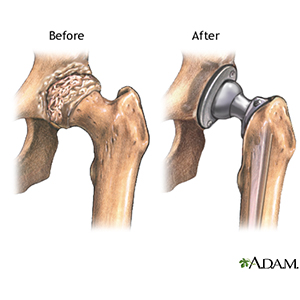WHAT YOU NEED TO KNOW: What do I need to know about total hip replacement? Total hip replacement (THR) is surgery to replace a hip joint damaged by wear, injury, or disease. It is also called total hip arthroplasty. The hip joint is where the top of your femur (thigh bone) sits in the socket of your pelvic bone. The joint is held together by ligaments and muscles. The top of your femur is shaped like a ball and covered with cartilage. Cartilage is a tissue that helps joints move. How do I prepare for THR? - The week before surgery:
- Ask a family member or friend to drive you home when you are discharged from the hospital. Ask someone to stay with you for the first week or two after surgery, in case you need help.
- You may need to move furniture around to make room for assistive devices that will be used after surgery. You may need crutches or a walker to get around safely.
- Keep all self-care items and most commonly used items within your reach. After surgery, you will need to avoid bending down or reaching over your head.
- You will not be able to sit or get up from low seating after surgery. Check to see if your chairs and toilet seats will cause problems.
- Ask your healthcare provider about other things you can do to make your home safer.
- Your healthcare provider may tell you not to eat or drink anything after midnight on the day of your surgery. He will tell you what medicines to take or not take on the day of your surgery.
What will happen during THR? - Your healthcare provider may use general anesthesia or a spinal block. General anesthesia will keep you asleep and free from pain during surgery. Ask your healthcare provider which of the following procedures is right for you:
- The conventional hip replacement involves one incision. Your healthcare provider will make the incision either along the front, side, or back of your hip.
- The minimally invasive hip replacement surgery involves a smaller incision that is about 4 to 8 inches in length. Your healthcare provider may make an incision along the front, side, or back of your hip. He will use fluoroscopy (a type of x-ray) to guide him during the surgery.
- The ball of your femur and the socket of your pelvis will be removed. A hip implant will replace the bones that were removed. Your healthcare provider may use medical cement to secure the implant parts. He may use an implant that has a porous surface. This surface allows your own bone to grow and fill the pores of the implant. Your healthcare provider may use both cement to hold the ball in place, and a porous socket implant. A drain may be placed to remove extra blood and fluids from the surgery area. Your incision will be closed with stitches or staples and covered with a bandage.

|
What will happen after THR? You may need to stay in the hospital for up to 5 days. Your healthcare providers will teach that it is important to cough and deep breathe after your procedure. Healthcare providers will teach you to use an incentive spirometer. When you cough, deep breathe, and use the incentive spirometer you decrease your risk of pneumonia. They will teach how to sit up and move without causing damage to your hip. You will have a special pillow between your legs to keep your legs from crossing and causing damage to your hip. You will be able to walk within the first day after surgery. You will be taught to use crutches or a walker to help keep pressure off your hip. You will be taught exercises to keep both legs strong and reduce the risk of blood clots. You will be wearing pressure stockings to help promote blood flow and prevent clots. What are the risks of THR? - Your implant may become loose or move out of place. If this happens, you may need another surgery to replace the implant. You may need surgery to remove infected tissues. You may need surgery to remove your implant if you have an allergic reaction to the materials. You may get a blood clot in your limb. This may become life-threatening.
- You may have more hip pain, or your hip joint may become stiff or numb. Your joint movement may not be as stable as it was before your surgery. You may have bone loss, or the bones near the implant area may break or crack. You may bleed more than expected or get an infection. Your nerves, blood vessels, ligaments, or muscles may be damaged during surgery.
|